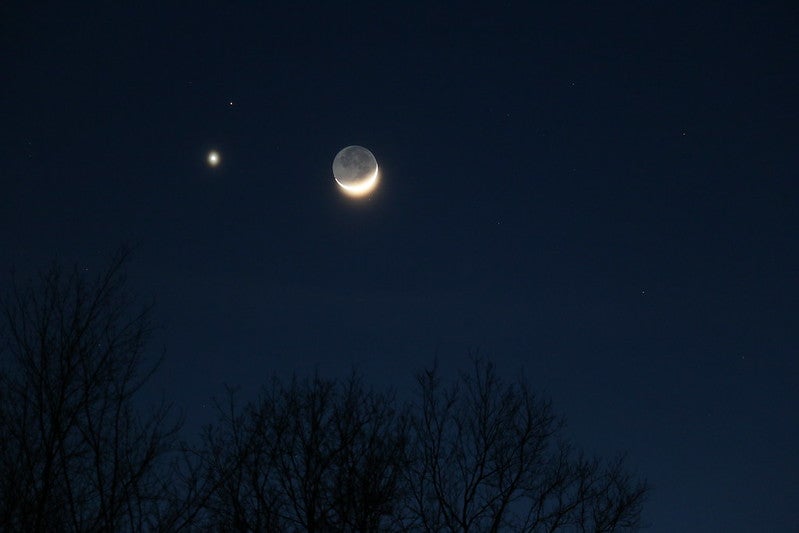
Friday, February 16
First Quarter Moon occurs this morning at 10:01 A.M. EST.
Rising in the east after sunset is the constellation Cancer the Crab. This star pattern houses a beautiful naked-eye open cluster at its heart: M44, also known as the Beehive Cluster. You can find it by first locating bright Castor and Pollux high in the eastern sky, some 60° above the horizon within two hours of sunset. Drop down toward the ground from these stars about 17° to find the Beehive.
This young group of stars spans nearly 100′ on the sky, making it just a bit smaller than the Pleiades in Taurus. They glow with a combined magnitude of 3.7, meaning the cluster is visible to the naked eye under good, dark conditions. It may appear more like a glowing, cloudy region than individual stars.
Even if you have trouble seeing it by eye, any pair of binoculars or small scope will bring these suns clearly into view, and the lower your magnification, the better. The Beehive contains a few hundred stars, which are about 600 million years old and lie roughly 500 to 600 light-years away.
Sunrise: 6:52 A.M.
Sunset: 5:37 P.M.
Moonrise: 10:33 A.M.
Moonset: 12:52 A.M.
Moon Phase: Waxing gibbous (51%)
*Times for sunrise, sunset, moonrise, and moonset are given in local time from 40° N 90° W. The Moon’s illumination is given at 12 P.M. local time from the same location.
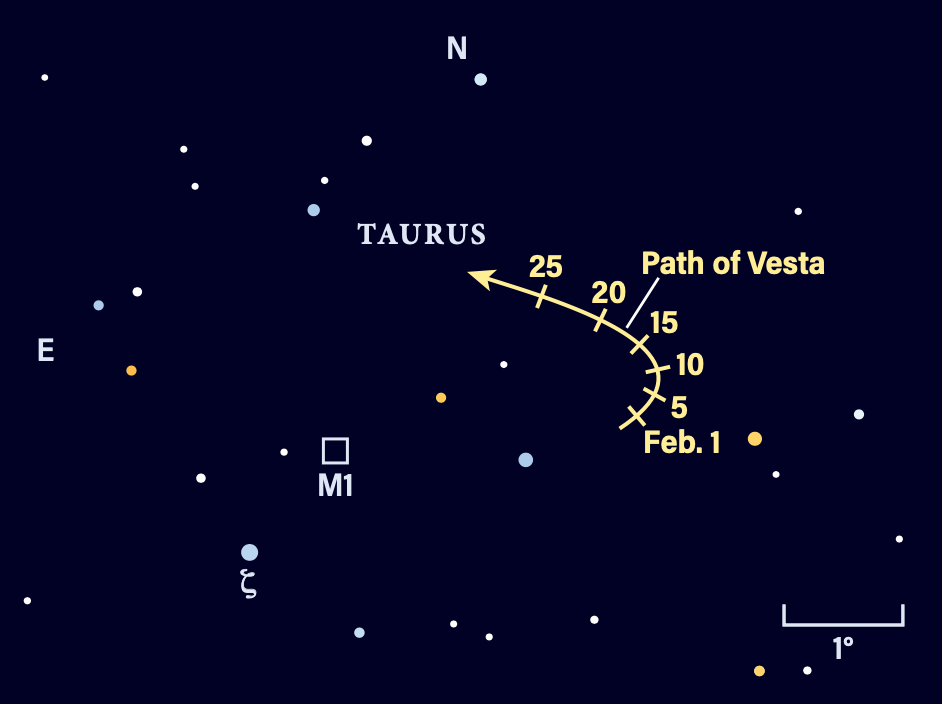
Saturday, February 17
Asteroid 4 Vesta remains bright this month, hovering midway between magnitudes 7 and 8. That makes it easy to catch in binoculars even from the suburbs.
It’s traveling through Taurus, which now rides high in the south a few hours after sunset. Although the brightening Moon is skimming through the same constellation, you should still be able to net Vesta, which recently switched from retrograde (westward) to prograde (eastward) motion.
Tonight, Vesta sits some 3.6° northwest of 3rd-magnitude Alheka (Zeta [ζ] Tauri), the easternmost of the Bull’s two horn tips. (The other horn tip, magnitude 1.7 Elnath, actually has a double designation: It is both Beta [β] Tauri and Gamma [γ] Aurigae, as it sits on the border between these two constellations!)
Vesta’s current position also puts it about 7.4° southeast of the waxing Moon tonight, though Luna’s brightness shouldn’t interfere with your search for the large, relatively bright main-belt world. Check out the star chart above to help you identify which point of light is Vesta. Note that even if you watch all night, you probably won’t be able to pick up the relatively nearby asteroid’s subtle motion against the more distant background stars — Vesta is moving too slowly this month to readily show its shifting over the course of just a few hours.
However, the Moon’s glare will likely wash out the nearby Crab Nebula (M1), just 2.5° east-southeast of Vesta. Don’t worry, though — once the Moon passes by and begins to wane, you can seek out this celestial treasure. Because of its slow movement, Vesta remains near the Crab all month, so we’ll make sure to revisit this region under darker skies later.
Sunrise: 6:51 A.M.
Sunset: 5:38 P.M.
Moonrise: 11:12 A.M.
Moonset: 2:02 A.M.
Moon Phase: Waxing gibbous (62%)
Sunday, February 18
The mighty planet Jupiter looms large and bright after sunset tonight. You’ll find it in the southwest an hour after sunset, glowing at magnitude –2.2. It’s the brightest point of light in the constellation Aries, far outshining the Ram’s brightest star, magnitude 2 Hamal.
Starting early in the evening, all four Galilean moons are readily visible, two on each side of the planet. Europa lies farthest west, with Ganymede closer to the limb; to the east, Io is closest to Jupiter, with Callisto much farther away.
Keep an eye on the planet for the next few hours and you’ll see a collective motion as the moons move west: Io closes in from the east while Ganymede and Europa pull farther away. Then, something interesting happens: Around 9:30 P.M. EST, a large, dark shadow appears on the cloud tops near Jupiter’s southern pole. This is Ganymede’s shadow — the distance between the planet and moon should emphasize the angle of the sunlight hitting the system, helping you map it in 3D in your mind.
The shadow crosses the polar region and begins to slip away shortly after 10 P.M. CST, after Jupiter has set for those on the East Coast. Those with high-elevation observing sites on the West Coast might just be able to catch the beginning of a transit as Io finally crosses in front of Jupiter right as the planet is sinking below the horizon. The timing will be close, and the world may be too low or have already disappeared by the time the transit begins.
Sunrise: 6:49 A.M.
Sunset: 5:39 P.M.
Moonrise: 11:59 A.M.
Moonset: 3:09 A.M.
Moon Phase: Waxing gibbous (72%)
Monday, February 19
Step outside this morning while it’s still dark to enjoy one of the world’s most famous asterisms: the Big Dipper. Part of the larger constellation Ursa Major, this group of seven (technically eight — one star is a double) stars forms the back half and elongated tail of the Big Bear, but on its own is thought to look like a cup with a long handle or even a plow.
Early this morning, the Dipper is standing on the edge of its cup with the handle sticking high in the air. Ursa Major, like many constellations around it, is called a circumpolar constellation because it appears to circle Polaris, the North Star that currently marks our North Celestial Pole.
If you’d like to see that aforementioned double star, look up to the very tip of the handle. That’s Alkaid. Slide your gaze to the next star in the handle, where it appears to “kink” — that’s magnitude 2.2 Mizar, and you may notice it’s accompanied by a slightly fainter star just 12′ to its northeast. That second star is magnitude 4 Alcor, and together they are sometimes called the horse and rider. The two can be separated with the naked eye if your vision is sharp! And if not, binoculars or a telescope will clearly show the pair of stars as two distinct points of light.
Mizar itself is also a double star, with components just 14″ apart. These can be split with most small telescopes, yielding even more celestial treasure. (And each of those is also a double, though they cannot be further split with scopes.) Alcor, too, is a double, with a companion just 1″ away — again, not discernible in a telescope.
Sunrise: 6:48 A.M.
Sunset: 5:40 P.M.
Moonrise: 12:53 P.M.
Moonset: 4:07 A.M.
Moon Phase: Waxing gibbous (80%)
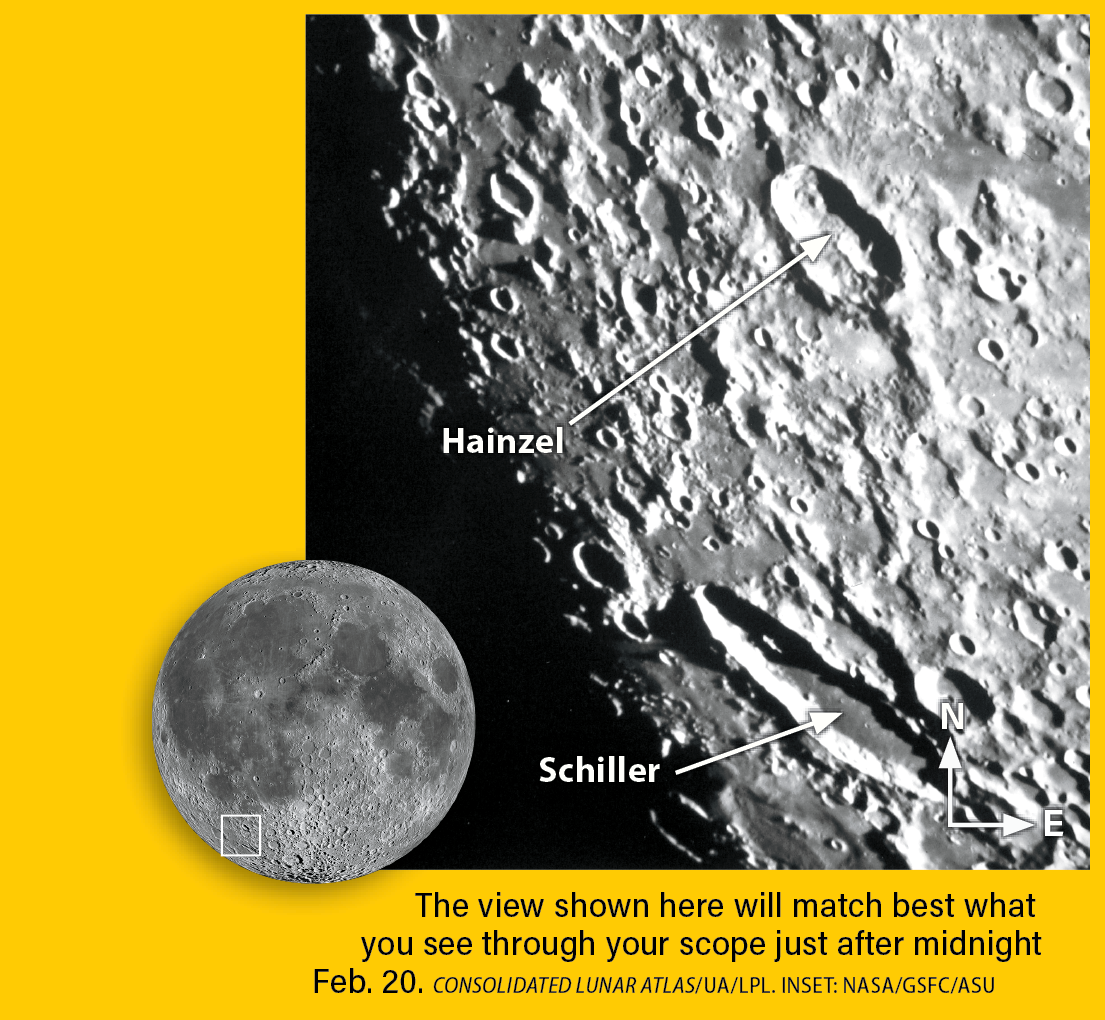
Tuesday, February 20
The Moon is now just a few days from Full, rising around 2 P.M. local time and well above the eastern horizon by the time the Sun has set. Tonight it sits nestled near the golden star Pollux, one of the two heads of Gemini the Twins.
Tycho is a prominent crater in the lunar south, made easy to spot by its broad, bright apron of ejecta — debris flung outward during the impact, streaking away from the crater. To Tycho’s southeast, now fully illuminated near the terminator separating lunar night from day, is the elliptical crater Schiller.
Schiller isn’t round because it was likely formed by an impact at a low, grazing angle, rather than a space rock coming at the Moon more head-on. (Although the crater isn’t circular by nature, it’s further misshapen by our viewpoint, as craters near the limb appear foreshortened from Earth.)
Slightly to Schiller’s northeast is a crater that might have you seeing multiple. This is Hainzel, which was formed by not one, but several impacts that occurred at different times, with later hits nearly overlapping those that came previous. The southeasternmost crater is shallowest and came first; then came the northwesternmost crater, which features a clear central peak. The craters sandwiched between the two came last.
Sunrise: 6:47 A.M.
Sunset: 5:42 P.M.
Moonrise: 1:53 P.M.
Moonset: 4:57 A.M.
Moon Phase: Waxing gibbous (87%)
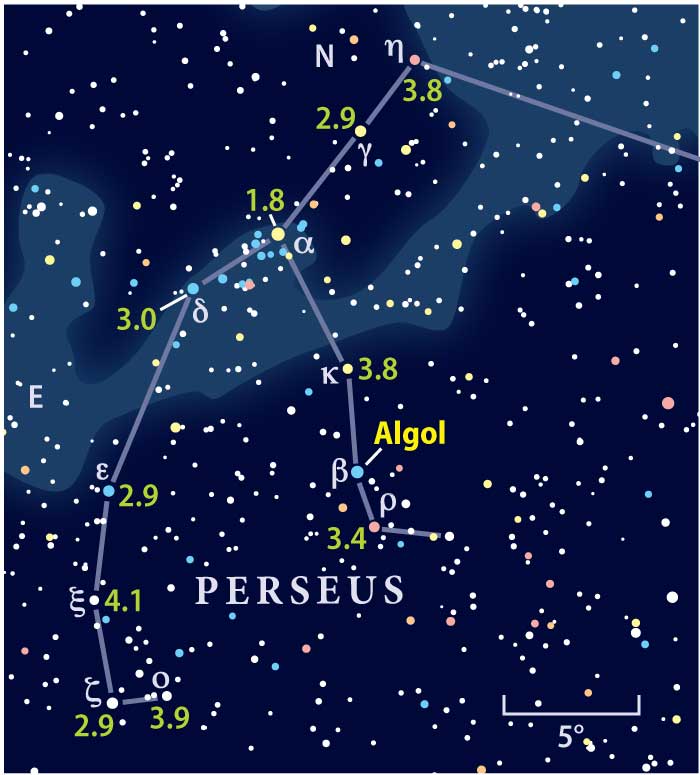
Wednesday, February 21
Let’s take a look at the Demon Star tonight — Algol in Perseus, also cataloged as Beta Persei. This 2nd-magnitude star is high in the west after sunset, offering plenty of time throughout the evening to observe it.
Use the chart above both to find the star and to determine its magnitude. Why might you need help determining its magnitude? Algol is called the Demon Star because it appears to the naked eye to brighten and fade over the course of just a few days. This variable is an eclipsing binary, which means it’s composed of two stars orbiting each other that eclipse one another from our particular point of view. When this happens, Algol dims from magnitude 2.1 to 3.4, then bounces back up to full brightness afterward. The entire cycle takes 2.87 days.
Today, Algol is at a minimum. Around 5:11 P.M. EST, the star hit its lowest magnitude of 3.4. The next minimum will occur on the 24th around 2 P.M. EST. See what the star looks like tonight compared to its neighbors — the chart above lists the magnitudes of nearby stars in green, which will allow you to compare Algol with them. Then, step outside on subsequent nights and make the same observation, again comparing it to nearby suns. You’ll be able to spot for yourself the star brightening as it comes out of eclipse!
Sunrise: 6:45 A.M.
Sunset: 5:43 P.M.
Moonrise: 2:56 P.M.
Moonset: 5:38 A.M.
Moon Phase: Waxing gibbous (93%)
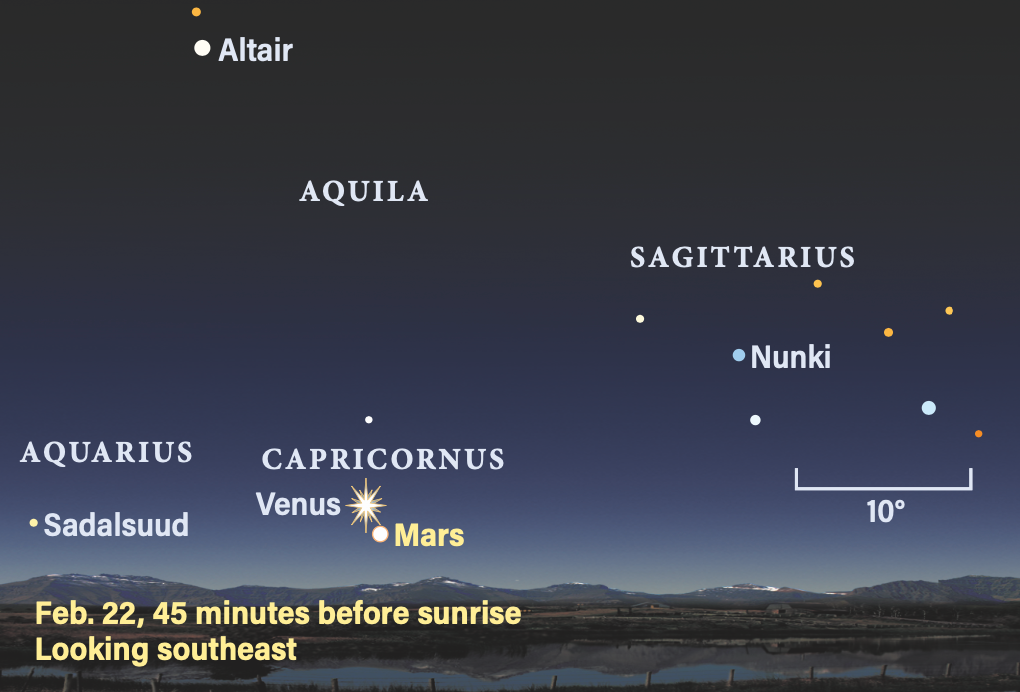
Thursday, February 22
Venus passes 0.6° north of Mars at 11 A.M. EST this morning. The close conjunction is visible the pre-dawn sky with no optical aid required.
Step outside about 45 to 60 minutes before sunrise and look southeast. Both planets are in the constellation Capricornus, now rising beneath the bright star Altair in Aquila. Venus is easy to spot at magnitude –2.3, but note it is very low, only 4° above the horizon. To Venus’ lower right is Mars. The Red Planet is a much fainter magnitude 1.3, which will make it hard to identify so close to the horizon and in the growing twilight. Nonetheless, both are visible to the naked eye, particularly if you can get to an observing site higher than your surroundings, with a clear view of the southeastern horizon and no trees or buildings in the way.
If you do need a little help, never fear — any binoculars or telescope will pick up the pairing, showing both planets together in the same field of view. Venus is now 11″ across, with a nearly full gibbous disk some 90 percent lit. By contrast, Mars appears fully illuminated but is less than half Venus’ size, spanning just 4″.
Day by day, the two planets will now pull apart, with Venus starting to sink and Mars appearing to rise in the sky when viewed at the same time each morning. They end the month next week with more than 3° between them.
Sunrise: 6:44 A.M.
Sunset: 5:44 P.M.
Moonrise: 4:00 P.M.
Moonset: 6:11 A.M.
Moon Phase: Waxing gibbous (97%)
Friday, February 23
Neptune, the solar system’s most distant planet, is sinking in the west as darkness falls after sunset. Today is a great time to find it, standing due north of the magnitude 5.5 star 20 Piscium today.
The observation is a bit challenging but certainly not impossible. About an hour after sunset, the pair is roughly 10 degrees high in the west, so you’ll simply need to be prepared to observe them earlier rather than later. They lie just over 4.5° south of the slightly brighter star Lambda (λ) Psc (magnitude 4.5), which marks the southeasternmost point in the Circlet of Pisces.
Neptune is just 8′ north of 20 Psc. The planet’s disk is a little less than 4″ wide and will likely appear as a small, “flat” star, much fainter than 20 Psc (Neptune is magnitude 7.8). Observers using either binoculars or any sized telescope will be able to catch the distant ice giant in their sights.
Sunrise: 6:42 A.M.
Sunset: 5:45 P.M.
Moonrise: 5:03 P.M.
Moonset: 6:38 A.M.
Moon Phase: Waxing gibbous (99%)

Sky This Week is brought to you in part by Celestron.









